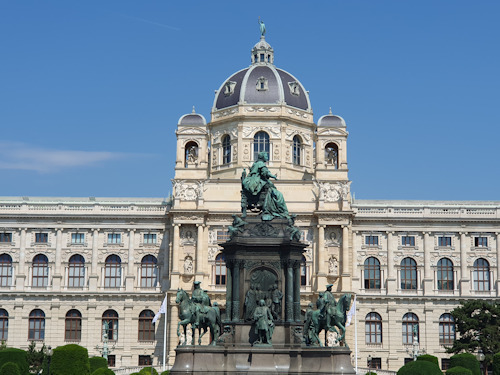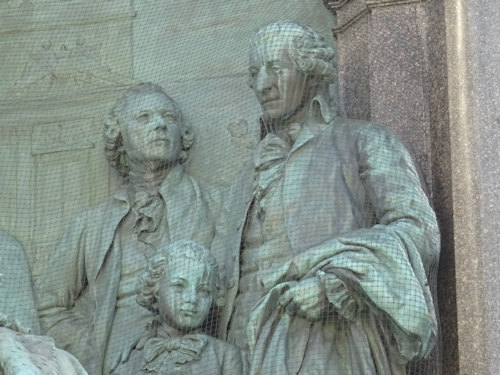
Many Habsburg monarchs got memorials shortly after their reign ended, but the monument honouring Empress Maria Theresa (1717-1780) took a little longer. One of her successors, Franz Joseph, unveiled it in 1888.
- The Empress towers over four sets of statues
- Each set represents a facet of her rule
- Mozart & Haydn also feature
- On a square between two gorgeous museums
- Book a short guided tour* for your Vienna trip
- See also:
The history

(The Naturhistorisches Museum begins on the right with the MuseumsQuartier at the back on the left)
The late 19th century was a time of great construction works in Vienna as architects and planners filled the space freed up by the removal of the city fortifications.
The area housing the Kunsthistorisches and Naturhistorisches museums formed one of the focal points for development. The two buildings face each other across Maria-Theresien-Platz, a square notable for the huge monument at its centre.
The monument pays tribute to the reign of Empress Maria Theresa, who inherited the Habsburg lands in a fairly precarious position and turned them into something rather more successful.

(The monument viewed from the Naturhistorisches Museum with the Kunsthistorisches Museum behind. Or possibly the other way around)
At the time of the unveiling (1888), construction work on the museums still continued, leading one satirical paper to note (my translation):
Now that the Maria Theresa monument has been unveiled, it would seem logical to put a veil over the museums, which are still not finished.
Maria Theresa’s political achievements came about without much help on the battlefield. She relied more on her strength of personality, as well as strategic marriages for her numerous kids.
One daughter (Maria Antonia) married the future Louis XVI of France, for example. You know her better as Marie Antoinette.

(Another view with the Kunsthistorisches Museum behind)
Various people contributed to the bronze, granite and serpentinite monument, including:
- The sculptor, Caspar von Zumbusch, who also produced the city’s famous Beethoven monument, and the Albrecht and Radetzky equestrian statues
- The architect, Carl von Hasenauer: a major contributor to many of the iconic buildings around the ring, including the two museums flanking the monument
- The historian, Alfred von Arneth, who had written a 10-volume biography of the Empress, so had a pretty good grasp of the themes and personalities that should appear alongside her

(Mistress of all that she sees)
Maria Theresa sits on a throne at the top of the monument, hand outstretched. Below her, the four riders are all military commanders bearing such names as Otto Ferdinand von Abensberg und Traun (Ferdi to his mates, presumably).
The four sides of the huge plinth feature groups of personalities representing, respectively, her advisors, her administration, the military, and arts & science.
Each side has a main character as a full statue and behind him (it was always a him), further individuals of the genre in partial relief.
Mozart and Haydn

(Gluck, Mozart and Haydn)
The side facing the Natural History Museum, for example, addresses the arts and sciences. The main figure is Gerhard van Swieten, Maria Theresa’s personal doctor, but also a key figure in the modernisation of medicine and medical teaching in 18th-century Vienna.
Of more interest to us are the composer figures behind van Swieten: Joseph Haydn stands next to Christoph Willibald Gluck.
Haydn once composed a symphony for the visit of the Empress to one of the palaces of his employers (the Esterházy family). On the relief, his hand rests on the right shoulder of a young boy: Mozart.
The two composers enjoyed a friendship based on mutual respect, despite the age difference (Haydn was around 24 years older). Mozart, of course, delighted the Empress as a child with a performance in Schönbrunn Palace. You can see the room it took place in on a palace tour.
How to get to the monument
If you’re taking in the main sights, you’re sure to see the monument in passing, anyway. It also sits in the middle of one of the main Christmas markets: the aptly-named Weihnachtsdorf on Maria-Theresien-Platz.
Go over the road to Heldenplatz square and look back through the monumental Äußeres Burgtor gateway to get a nice photo of Maria Theresa framed by its arches.
Subway: Take the U2 line to either Museumsquartier or Volkstheater (which is also a stop on the U3 line)
Tram: Most of the trams that travel along the Ring boulevard stop opposite the square (get out at either Burgring or Ring/Volkstheater). These include the lines 1, 2, 71, and D. The 46 and 49 lines also stop at the Ring/Volkstheater station
Bus: The 48A goes to Ring/Volkstheater, the 57A to Burgring
Address: Maria-Theresien-Platz, 1010 Vienna